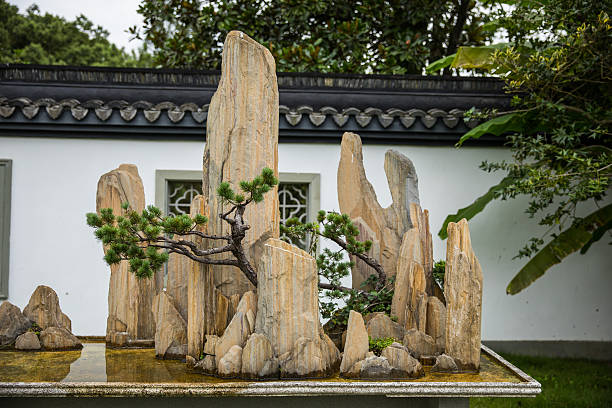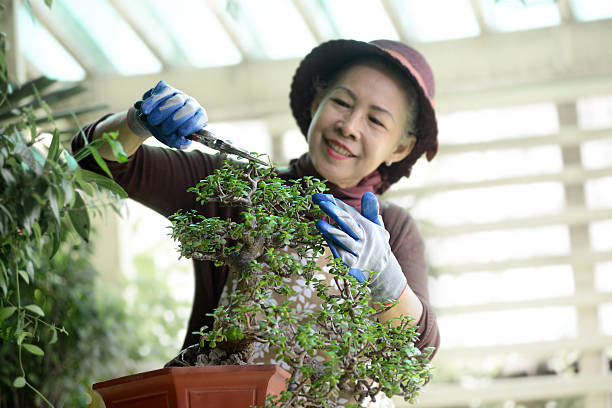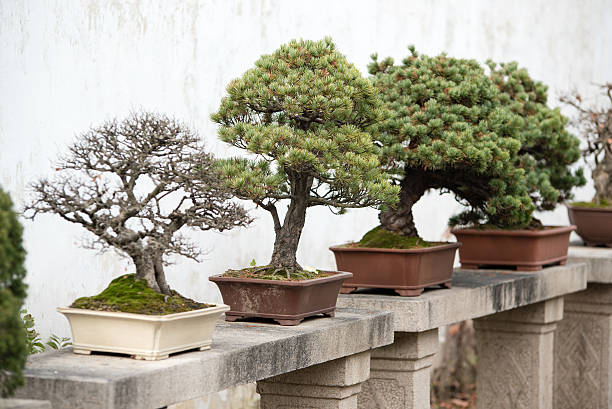Bonsai trees in literature have long captivated the imagination, intertwining nature’s artistry with human creativity. These miniature trees, more than just potted trees, embody a rich cultural significance that transcends geographical boundaries. Originating in East Asia and gaining global admiration, bonsai symbolize patience, diligence, and the harmonious balance between nature and human nurture.
Their presence in literature is not merely ornamental but often deeply symbolic, reflecting themes such as resilience, beauty in simplicity, and the passage of time.
Literary works, ranging from ancient poems to modern novels, have employed bonsai trees as potent symbols. They serve as metaphors for personal growth, the complexities of relationships, and the enduring spirit of nature amidst human adversity. In the realm of storytelling, a bonsai isn’t just a background element; it often becomes a character in its own right, representing a bridge between the tangible world and philosophical ideas.
This unique representation in literature not only highlights the aesthetic appeal of bonsai but also underscores their profound philosophical and spiritual undertones. Consequently, bonsai in literature offers a window into the soul, providing insights into both the natural world and the human condition.
Historical Roots Of Bonsai In Literature

The presence of bonsai trees in literature dates back centuries, with ancient texts painting vivid portraits of these dwarf trees. Rooted in Asian culture, particularly in China and Japan, bonsai were not only horticultural achievements but also artistic expressions and philosophical symbols.
Early Chinese literature, like classical poems and philosophical texts, often alluded to miniature trees, reflecting the Taoist admiration for nature and simplicity. These references laid the groundwork for the symbolic role of miniature trees in literature, embodying themes of harmony and balance.
As the art of bonsai cultivation, or ‘bonsai basics,’ spread to Japan, it gained significant literary prominence. Japanese literature, especially during the Heian period, saw bonsai as emblems of elegance and aristocratic refinement. Works from this era, including courtly poetry and narratives, frequently mentioned bonsai, showcasing their aesthetic appeal and cultural value.
The transition of bonsai from ancient to modern literary works showcases a fascinating evolution. In earlier texts, bonsai were revered for their natural beauty and philosophical implications, while contemporary literature often uses them to symbolize intricate human emotions and experiences.
Bonsai As A Symbol Of Harmony And Balance
Literary works often depict bonsai trees as symbols of harmony and balance, reflecting their intrinsic aesthetic beauty. The meticulous and deliberate art of bonsai is a mirror to life’s delicate equilibrium. Authors across cultures and eras have turned to bonsai to illustrate this balance, drawing parallels between the careful cultivation of these miniature trees and the crafting of a balanced life.
The symbolism of bonsai extends beyond its physical appearance, delving into the philosophy behind its practice, encompassing both outdoor and indoor bonsai varieties. Each snip of a branch or adjustment of a wire in bonsai cultivation is a thoughtful act, mirroring the conscious decisions we make in our lives. Literary works often utilize bonsai to exemplify the idea that beauty and serenity are achievable through careful attention and nurturing.
A Literary Symbol Of Balance
Notable examples in literature not only showcase bonsai trees as static symbols but also as dynamic elements that interact with characters and settings. These examples include:
- Ancient East Asian Literature: Texts like “The Analects” and “The Tale of Genji” use bonsai to symbolize the balance between nature and human intervention, reflecting on the cultivation and refinement of one’s character.
- Western Literature: In works such as “The Secret Life of Bonsai” by Akio Nakamura and “The Bonsai Tree” by David Mitchell, bonsai represents a connection to nature, embodying themes of patience and beauty.
- Poetry: Haiku and other poetic forms often capture the tranquility and visual beauty of bonsai, using it as a metaphor for human experience and introspection.
- Short Stories: Bonsai is employed to explore the relationships between humans and nature, serving as a metaphor for personal growth and transformation.
- Novels: In “The Bonsai Apprentice” by M.D. Murray and “The Art of Hearing Heartbeats” by Jan-Philipp Sendker, bonsai serves as a recurring theme symbolizing personal transformation and the passage of time.
In these narratives, bonsai often serves as a metaphor for characters seeking balance in their lives, whether in tumultuous love stories, journeys of self-discovery, or tales of reconciliation.
Bonsai In Character Development And Plot Progression

In the intricate tapestry of storytelling, the motif of bonsai trees in literature often plays a significant role in character development and plot progression. These miniature trees, symbols of patience and care, reflect the inner journeys of characters associated with bonsai cultivation. Such characters are usually portrayed as deeply contemplative, showcasing an intimate bond with nature and an attention to the finer details of life.
The act of nurturing bonsai, a central theme in many literary works, mirrors the personal growth and transformation of these characters. For instance, a character grappling with life’s complexities might find a sense of purpose and tranquility in the routine of caring for a bonsai. This parallelism between the character’s evolution and the bonsai’s growth adds depth to the narrative, highlighting themes of resilience, mindfulness, and the healing power of nature.
Furthermore, the inclusion of bonsai in literature can serve as a powerful plot device. The bonsai may symbolize a key relationship, its flourishing or decline mirroring the emotional landscape of the story. In some tales, the care of a bonsai represents a cherished family tradition, influencing the narrative through themes of heritage and continuity.
Bonsai As A Metaphor For Life And Resilience
In the literary world, bonsai trees often serve as profound metaphors for life and resilience. Explored through various narratives, bonsai are not just aesthetic elements but also reflections of life’s journey and the human spirit’s tenacity.
Authors frequently use bonsai to symbolize the delicate balance of life, illustrating how resilience can be fostered through care and attention. Just as a bonsai grows and thrives under the mindful care of its cultivator, characters in literature often parallel this growth, overcoming obstacles and evolving through their experiences.
This metaphorical use of bonsai offers a unique lens through which readers can explore the complexities of life and the beauty of persisting against odds.
Insights from bonsai journals and magazines further enrich these literary portrayals. They provide a deeper understanding of the bonsai’s symbolic significance, offering perspectives on how these miniature trees embody philosophical and emotional resilience.
The Influence Of Bonsai Styles On Literary Descriptions
The varied styles of miniature trees in literature enrich visual imagery and significantly influence narrative tone and setting. Each bonsai style, with its distinct form and expression, offers a unique contribution to literary descriptions, deepening the story’s thematic resonance and ambiance.
Classic bonsai styles frequently depicted in literature include:
- Kengai (Cascade): Symbolizes strength and endurance, often mirroring a character’s resilience.
- Chokkan (Formal Upright): Represents stability and balance, reflecting a story’s central themes of harmony.
- Shakan (Slanting): Illustrates dynamism and movement, akin to a character’s journey or growth.
- Fukinagashi (Windswept): Evokes feelings of struggle and perseverance, aligning with narratives of overcoming adversity.
- Yose-ue (Group Planting): Symbolizes community and interconnectedness, often used to represent collective experiences or relationships.
The specific mention of bonsai trees in literature with these styles impacts the mood and setting of a scene. For instance, the contemplative nature of a meticulously crafted bonsai sets a reflective tone, while a rugged, naturalistic style might evoke a sense of freedom and wildness. These stylistic choices in describing bonsai enable authors to subtly influence the reader’s perception and emotional connection with the narrative.
Moreover, bonsai styles in literature often reflect the cultural or geographical backdrop of the story, adding authenticity and enriching the narrative setting.
Bonsai And The Art Of Storytelling

Just as a bonsai artist carefully prunes and shapes a tree, a storyteller crafts a narrative, meticulously developing characters, setting, and plot. This artistic parallel is evident in bonsai in literature, where the influence of the bonsai empire and its rich heritage of classic bonsai narratives profoundly enriches storytelling.
These narratives, deeply rooted in cultural tradition, often find their way into literature, providing a backdrop that deepens the narrative tapestry. Classic bonsai styles and the philosophies behind them serve as allegories, offering insights into characters’ journeys and the stories’ deeper meanings.
The bonsai’s ability to encapsulate entire worlds within its miniature form parallels a writer’s ability to create vast universes within the confines of a story. Both arts celebrate the beauty of subtlety and the power of small details to convey larger truths.
Through miniature trees in literature, we see a reflection of the intricate craft of storytelling, where every element, much like the careful shaping of a bonsai, contributes to the overarching beauty and meaning of the narrative.
Modern Literature And The Evolving Symbolism Of Bonsai
In recent literary works, bonsai often symbolizes the complexities of the modern world—themes of urbanization, environmental consciousness, and the search for identity in a fast-paced society. The intricate care and patience required for bonsai cultivation are juxtaposed with the often chaotic and hurried lifestyle of contemporary life, creating a poignant contrast.
This shift in symbolism also sees bonsai being used to represent resilience in the face of adversity, mirroring the tenacity required to navigate the complexities of the modern world. The metaphor of a bonsai thriving in a confined space is increasingly employed to illustrate the human capacity to adapt and flourish under challenging circumstances.
Moreover, modern literature often highlights the diversity of bonsai aesthetics and styles, using them to symbolize various cultural identities and narratives. This inclusivity in representation aligns with the broader themes of globalization and multiculturalism prevalent in contemporary storytelling.
Contributions Of Bonsai Organizations In Literature
The representation of miniature trees in literature is significantly influenced by various bonsai organizations, which play a vital role in shaping public perception and understanding of this art form. These organizations are not only custodians of bonsai culture but also serve as inspirations and references in literary works, bringing authenticity and depth to the portrayal of bonsai.
- Nippon Bonsai Association: Often featured in literature, this organization symbolizes the deep-rooted traditions of bonsai in Japanese culture. It is frequently referenced in stories that explore the historical and cultural significance of bonsai, especially in the context of Japanese literature.
- National Bonsai Foundation: This foundation, based in the United States, represents the globalization of bonsai culture. Literature referencing this organization often discusses the spread of bonsai art beyond its Asian origins, reflecting on themes of cultural exchange and adaptation.
- International Bonsai Arboretum: Featured in contemporary literary works, this organization highlights the global appreciation of bonsai art. It symbolizes the universal appeal of bonsai, transcending cultural and geographical boundaries.
- American Bonsai Society: Representing the adoption and adaptation of bonsai art in the West, this society is often mentioned in literature to discuss the fusion of Eastern and Western aesthetics and philosophies.
- European Bonsai Association: This organization’s presence in literature signifies the widespread appeal of bonsai across continents. It often appears in narratives exploring the diverse interpretations and styles of bonsai in different cultural contexts.
The contributions of these organizations to miniature trees in literature extend beyond mere mentions; they enrich the narratives by providing insights into the bonsai practice, its global journey, and its evolving aesthetics.
Explore Bonsai’s Impact In Literature Today
The intertwining of bonsai trees in literature with literary expression elegantly showcases bonsai’s profound impact on storytelling. These miniature trees, symbolizing resilience and harmony, continue to enrich narratives across cultures. As bonsai in literature has evolved, it parallels the growth and adaptation seen in bonsai cultivation itself, similar to the diverse gardening essentials offered by Leaves And Soul, enhancing home gardening experiences.
Reflecting on Bonsai’s literary journey, it’s clear that they have transcended their physical form to become potent symbols, evolving from traditional cultural icons to modern metaphors reflecting life’s complexities. This evolution, enriched by the contributions of bonsai organizations, has broadened public appreciation and understanding of miniature bonsai.
The synergy between bonsai and literary expression is a dynamic blend of nature and narrative. This enduring relationship continues to captivate and inspire, much like the meticulous nurturing of a bonsai, embodying the art of storytelling and the beauty of life’s journey.





0 Comments